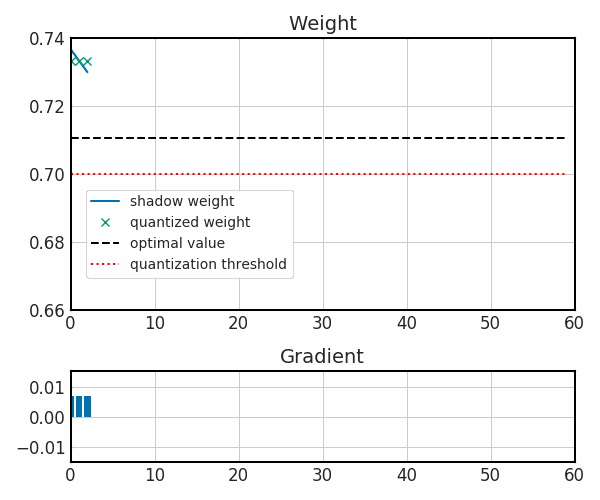This repository containes the implementation and experiments for the paper presented in
Markus Nagel*1, Marios Fournarakis*1, Yelysei Bondarenko1, Tijmen Blankevoort1 "Overcoming Oscillations in Quantization-Aware Training", ICML 2022. [ArXiv]
*Equal contribution 1 Qualcomm AI Research (Qualcomm AI Research is an initiative of Qualcomm Technologies, Inc.)
You can use this code to recreate the results in the paper.
If you find our work useful, please cite
@InProceedings{pmlr-v162-nagel22a,
title = {Overcoming Oscillations in Quantization-Aware Training},
author = {Nagel, Markus and Fournarakis, Marios and Bondarenko, Yelysei and Blankevoort, Tijmen},
booktitle = {Proceedings of the 39th International Conference on Machine Learning},
pages = {16318--16330},
year = {2022},
editor = {Chaudhuri, Kamalika and Jegelka, Stefanie and Song, Le and Szepesvari, Csaba and Niu, Gang and Sabato, Sivan},
volume = {162},
series = {Proceedings of Machine Learning Research},
month = {17--23 Jul},
publisher = {PMLR},
pdf = {https://proceedings.mlr.press/v162/nagel22a/nagel22a.pdf},
url = {https://proceedings.mlr.press/v162/nagel22a.html}
}
When training neural networks with simulated quantization, we observe that quantized weights can, rather unexpectedly, oscillate between two grid-points. This is an inherent issue problem caused by the straight-through-estimator (STE). In our paper, we delve deeper in this little understood phenomenon and show that oscillations harm accuracy by corrupting the EMA statistics of the batch-normalization layers and by preventing convergence to local mimima.
We propose two novel methods to tackle oscillations at their source: oscillations dampening and iterative state freezing We demonstrate that our algorithms achieve state-of-the-art accuracy for low-bit (3 & 4 bits) weight and activation quantization of efficient architectures, such as MobileNetV2, MobileNetV3, and EfficentNet-lite on ImageNet.
Make sure to have Python ≥3.6 (tested with Python 3.6.8) and
ensure the latest version of pip (tested with 21.3.1):
source env/bin/activate
pip install --upgrade --no-deps pipNext, install PyTorch 1.9.1 with the appropriate CUDA version (tested with CUDA 10.0, CuDNN 7.6.3):
pip install torch==1.9.1 torchvision==0.10.1Finally, install the remaining dependencies using pip:
pip install -r requirements.txtThe main run file to reproduce all experiments is main.py.
It contains commands for quantization-aware training (QAT) and validating quantized models.
You can see the full list of options for each command using python main.py [COMMAND] --help.
Usage: main.py [OPTIONS] COMMAND [ARGS]...
Options:
--help Show this message and exit.
Commands:
train-quantizedAll models are fine-tuned starting from pre-trained FP32 weights. Pretrained weights may be found here
- MobileNetV2
- EfficientNet-Lite: pretrained weights from repository (downloaded at runtime)
To train with oscillations dampening run:
python main.py train-quantized --arhcitecture mobilenet_v2_quantized
--images-dir path/to/raw_imagenet --act-quant-method MSE --weight-quant-method MSE
--optimizer SGD --weight-decay 2.5e-05 --sep-quant-optimizer
--quant-optimizer Adam --quant-learning-rate 1e-5 --quant-weight-decay 0.0
--model-dir /path/to/mobilenet_v2.pth.tar --learning-rate-schedule cosine:0
# Dampening loss configurations
--oscillations-dampen-weight 0 --oscillations-dampen-weight-final 0.1
# 4-bit best learning rate
--n-bits 4 --learning-rate 0.0033
# 3-bits best learning rate
--n-bits 3 --learning-rate 0.01To train with iterative weight freezing run:
python main.py train-quantized --arhcitecture mobilenet_v2_quantized
--images-dir path/to/raw_imagenet --act-quant-method MSE --weight-quant-method MSE
--optimizer SGD --sep-quant-optimizer
--quant-optimizer Adam --quant-learning-rate 1e-5 --quant-weight-decay 0.0
--model-dir /path/to/mobilenet_v2.pth.tar --learning-rate-schedule cosine:0
# Iterative weight freezing configuration
--oscillations-freeze-threshold 0.1
# 4-bit best configuration
--n-bits 4 --learning-rate 0.0033 --weight-decay 5e-05 --oscillations-freeze-threshold-final 0.01
# 3-bit best configuration
--n-bits 3 --learning-rate 0.01 --weight-decay 2.5e-05 --oscillations-freeze-threshold-final 0.011For end user's convenience, bash scripts are provided under /bash/ for reproducing our experiments.
./bash/train_mobilenetv2.sh --IMAGES_DIR path_to_raw_imagenet --MODEL_DIR path_to_pretrained_weights # QAT training of MobileNetV2 with defaults (method 'freeze' and 3 bits)
./bash/train_efficientnet.sh --IMAGES_DIR path_to_raw_imagenet --METHOD damp --N_BITS 4